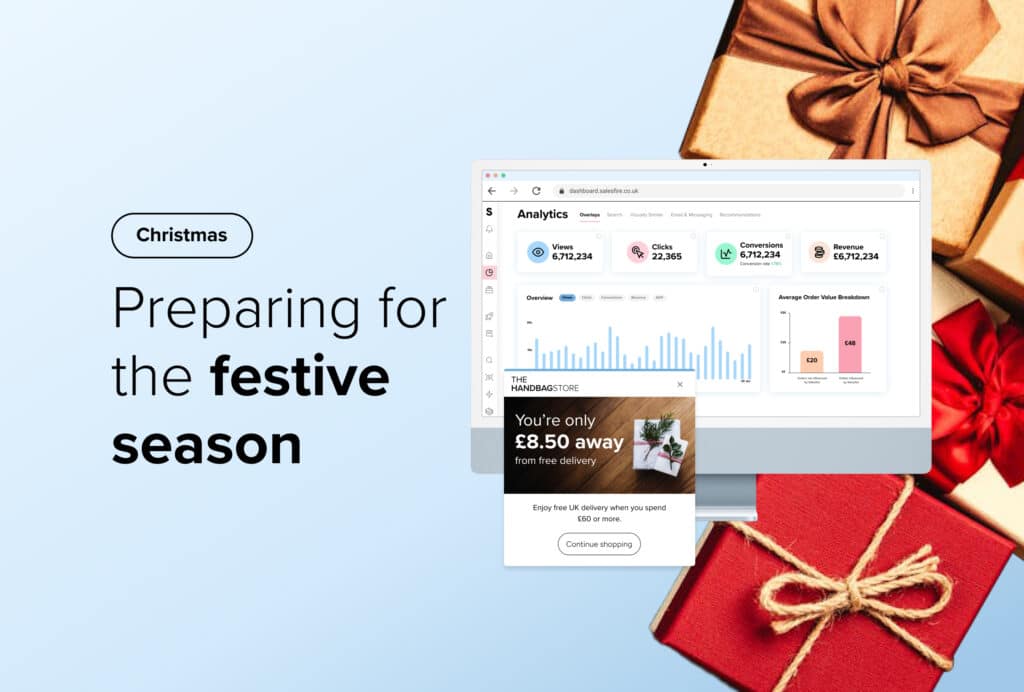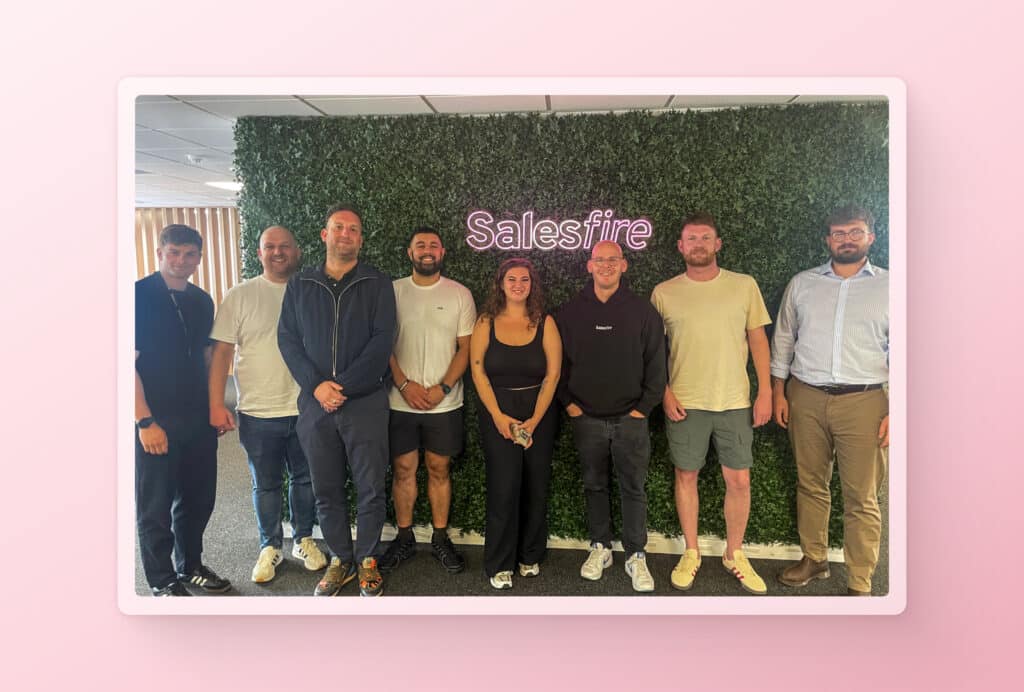‘Tis the Season: Getting Your eCommerce Site Ready For Christmas
By Bethany Llewellyn • Last updated: Friday Nov 7th, 2025

eCommerce Christmas shopping is already ramping up, meaning there’s plenty of high-intent festive traffic for your brand to capitalise on.
Whilst it’s the season of sales, shoppers are still recovering from the cost-of-living crisis and facing new economic challenges. This means your eCommerce site will need to work hard to get your visitors to convert.
Optimising your site to enhance the shopping experience is the first step to a successful Christmas in eCommerce. Read on to discover our top recommendations to prepare your site for the festive season.

The importance of your Christmas shoppers
For many online retailers, Christmas is the busiest time of the year. In recent years, consumer behaviour has shifted, and shoppers are searching for Christmas gifts earlier than ever.
The festive season presents the perfect opportunity to attract new customers. On average, eCommerce retailers report a 50% increase in transactions from first-time buyers.1
This is due to the vast number of consumers who head online specifically to scout for Christmas deals and promotions.
Providing a great experience to every shopper is more important than ever, especially at this time of year. With rising acquisition costs, anyone who lands on your site is highly valuable. You’ll want to maximise revenue from these shoppers by minimising bounce rates on your site and making shopping effortless.
Preparing for Q4
An unstable economy and ever-increasing data privacy concerns bring uncertainty to eCommerce that will no doubt spill into this Q4.
However, preparing in advance can help to ensure you develop an effective Christmas eCommerce strategy. Consider doing the following:
- Researching and analysing last year’s data using Salesfire Trends
- Launching your Christmas ads and marketing campaigns sooner
- Monitoring stock levels to prepare for an influx of orders
- Identifying and addressing website pain points for a seamless user experience
It’s also a good idea to review any issues your brand could face over the Christmas period and plan around these.
Ahmed, Chief Strategy Officer at PPC specialists, Circus PPC, explores some of the problems online retailers can face around Christmas:
“Some of the issues that we’ve seen retailers fall victim to at this key time include running out of stock, which can be due to a lack of prior research into trends and potential demand for key products.
“It sounds obvious, but being thorough is one of the most important things you can do to avoid small, unnecessary mistakes such as incorrect product prices and unclear shipping times – both of which should be clearly defined and accessible to those visiting your website. If not, this could lead to far fewer conversions than expected due to incorrect pricing details as well as confusion or complaints from customers who haven’t been correctly informed of shipping times.”2
Ensuring your business is in the best possible position ahead of peak season traffic will help you maximise Christmas sales.
How to optimise your site ahead of Christmas
When receiving an influx of returning customers and new visitors over Christmas, you’ll want to avoid deterring them with an unoptimised shopping experience.
Below, we’ve highlighted some common pain points you might face at this time of year, along with our suggested solutions.
1. Solve low customer retention rates
Retaining your festive shoppers beyond the Christmas season is essential to growing your business.
If your retention rate is low, you’ll likely lose many of your new shoppers as soon as they’ve completed their Christmas shopping. So, focusing on strategies that increase customer retention is essential for turning more of your new shoppers into long-term customers.
Average customer retention rates across industries are typically between 70-80% meaning a low retention rate is considered anything below this.3
Boosting customer retention can help drive growth in several ways:
- Improved return on investment (ROI): Just a 5% increase in customer retention can increase your profits by as much as 95%.4
- Increased revenue and AOV: Returning customers buy more often and spend more money than new customers.
- Referrals: Customers who’ve had a positive experience are more likely to recommend their family and friends, bringing new customers to your site.
If your retention rate is poor, the Christmas period is a great opportunity to experiment with ways to improve it.
The solution
Boost your retention rate by creating an effortless shopping experience.
Try implementing the following to optimise your on-site touchpoints:
- Display delivery and return information: Ensure your delivery and return options are clearly displayed on your site to set expectations and prevent confusion.
- Display seasonal messaging: With many shoppers visiting your site in search of gifts, set up on-site messaging campaigns that highlight your most relevant deals and products.
- Make your site mobile-friendly: Mobile devices were a key driver of sales in Q4 2024, and this year will be no exception. Optimise your website for all customers, regardless of whether they shop on desktop or mobile.
By providing a seamless first experience to visitors on your site, they’ll be more likely to return to shop again. This can help to drive up your customer retention rate, which will positively impact your profits.
Suggested reading: How to Convert Christmas Gift Shoppers into Loyal Customers
2. Create personalised customer experiences
Personalisation is the foundation of a successful eCommerce marketing strategy. It’s also something customers have come to expect from their Christmas shopping experience.
From emails featuring targeted gift guides to on-site personalisation, these details can make or break a shopper’s decision to convert.
One generic interaction could be all it takes for a shopper to become disengaged from your brand and start shopping elsewhere.
The solution
Use AI-powered tools to level up your personalisation with minimal effort.
For example, with Salesfire’s Recommendations, you can display suggested products that are personalised to each shopper’s activity and interests.
By offering personalisation, you’ll create more memorable and valuable shopping experiences that will help to strengthen your shopper relationships.
You’ll also help shoppers connect more easily with items they’re interested in, which can help boost your AOV and drive profits.
Personalising your touchpoints as much as possible is essential for maximising conversions and capturing loyal customers over the Christmas period.
Suggested reading: How SMEs Can Achieve Personalisation at Scale
3. Resolve slow site speeds
Slow load times on your site can result in lost customers.
In a period when your site visitors will be at their highest, you’ll want to avoid anything that could deter them. Especially when the issue can be fixed so easily.
An increase in your site’s load time of just 2 seconds makes users 32% more likely to bounce.5
When addressing speed and usability issues, it’s important to consider the speed of your search bar.
A slow search speed can prevent shoppers from continuing their journey on your site. It can also drive them to your competitors on the hunt for a better user experience.
The solution
Upgrade your on-site search function.
Advanced solutions like Salesfire’s Search harness artificial intelligence to deliver relevant and accurate results to your shoppers quickly.
This ensures shoppers can find what they are looking for before their buying intent drops, increasing their likelihood of converting.
Improving your search can bring other benefits to your brand, including:
- Encouraging shoppers to browse more products
- Standing out from competitors that offer poor search functionality
- Enhancing your overall customer experience
At Christmas, when many visitors will likely be new to your site, your search can greatly influence their first impression. Therefore, it’s important you do everything you can to optimise it prior to the busy Christmas season.
4. Review your data capture strategy
The festive period houses some of the busiest days in the eCommerce calendar, from Black Friday to Boxing Day. With shoppers scouring the internet for deals and gifts, online retailers can expect to receive much higher website traffic than usual.
However, the number of promotions available means shoppers will usually jump between multiple sites, with the chance of purchasing elsewhere. If you want to reach them again after they leave, you’ll need to capture an email or mobile number during their visit.
If your site is not optimised for data capture, you’ll lose the opportunity to recover many potential sales from undecided shoppers.
The solution
Use data capture campaigns on your site to maximise the data you collect from shoppers.
Display clear messaging and offer a monetary incentive to motivate more shoppers to share their email address or mobile number.
Using data capture technology can also help to drive sign-ups by automatically displaying campaigns at the optimal moments in the shopper’s journey.
Having access to first-party data allows you to extend the window of time you can communicate with your shoppers. It can also help to enhance your paid ad strategy. The data you collect directly from your shoppers can be used to build more accurate ad audiences and improve your ad targeting, too.
Suggested reading: Discover how Leisure Lakes Bikes captured 4.5x more shopper data using data capture technology.
5. Retarget abandoning users
The average cart abandonment rate across all eCommerce industries is around 70%.6 This means out of every ten shoppers who add something to their cart, seven will leave without completing their order.
This figure is likely to be even higher around Christmas, when shoppers are in search of the perfect gifts. At this time, it’s easy for shoppers to forget about their baskets or plan to return to them later after shopping around.
Shoppers who add items to their cart are showing high buying intent. So, without an effective retargeting strategy to entice them back to complete their purchase, they could end up spending elsewhere.
This can result in lost revenue for your business and increased revenue for your competitors.
The solution
Set up abandonment flows that remind shoppers of their basket and encourage them to return to your site.
Using an automated retargeting solution can help you effortlessly deliver the right message at the right time in a shopper’s journey.
For example, Salesfire uses real-time shopper data to automatically trigger personalised email and SMS abandonment flows that:
- Maximise open and click-through rates
- Effectively re-engage potential customers
- Reinject shoppers into the buying journey
A perfectly timed retargeting flow can allow you to re-capture a shopper’s interest in their bagged items. It can make all the difference in whether they decide to return and complete their festive purchase on your site.
Suggested reading: The Ultimate Email Retargeting Checklist
6. Utilise social media
With the chaos that is the lead-up to Christmas, it can be tempting to neglect your social media channels. You may opt to focus on more direct marketing channels, such as email or your website itself.
However, with 1 in 4 internet users stating they use social media in search of things to do or buy, it’s too risky to ignore. 7 If you’re not using social media around Christmas, you’re missing out on tapping into audiences who are ready to buy.
With so many retailers investing in traditional Christmas advertising campaigns and offering seasonal promotions, social media provides a way to connect with buyers on a personal level, building relationships that make your brand stand out from the competition.
So how can you utilise social media effectively?
The solution
Invest sufficient time and resources into your social media accounts to raise brand awareness and drive more traffic to your website during the Christmas period.
You can do this by:
- Using relevant platforms: There are now so many social media platforms available to choose from. While you want to reach as many people as possible, focus on the platforms with audiences most relevant to your brand.
- Showcasing your brand’s personality: Stay professional, but have fun with social media. Be more informal, give users a peek behind the scenes this Christmas, or even give your logo a festive makeover. However, keep things consistent across platforms to ensure customers recognise your brand.
- Planning ahead: Build a social media content calendar and create and schedule your posts in advance. This will free up your time to focus on reacting to any seasonal social media trends.
- Generating urgency: Let social media users know about any time-sensitive deals or promotions, encouraging them to visit your site before time runs out.
- Directing users to an optimised eCommerce website: Include links in your social media posts, so users can easily click through to your store to make a purchase.
Social media is a great way to reach new customers and show off more of your brand’s personality. However, your website is key to capitalising on this new social media traffic. Your site must be effective at converting new traffic into customers, or your social media efforts are wasted.

Final thoughts
It’s wise to expect a surge in website traffic throughout the holiday season. Allow your brand to make the most of this by preparing your site ahead of time.
Focus on optimising key touchpoints such as your on-site search and consider how you can incorporate personalisation into the customer journey. If you want to achieve peak performance this final quarter, providing a great experience to every shopper is essential.
1 Is Customer Acquisition Worth it During the Holidays? | TotalRetail
3 Average Customer Retention Rates by Industry in 2025 | Shopify
4 The Value of Keeping the Right Customers | Harvard Business Review
5 Marketing Strategies | Think with Google
6 50 Cart Abandonment Rate Statistics 2025 | Baymard Institute
7 Key Social Commerce Statistics You Should Know in 2023 | Influencer Marketing Hub
Discover how Salesfire can help you prepare your site for the Christmas period. Email one of our experts at [email protected] or request a free demo of our optimisation technology.



